Discover the timeless beauty of vintage wild flower art with this stunning free collection of botanical illustrations by Harriet Isabel Adams.
I hadn’t heard of Harriet Isabel Adams until a reader asked if I had seen her wild flower drawings.
After an online hunt, I found a botanical book she’d published, “Wild Flowers of the British Isles“. The book was in two volumes, the first in 1907 and the second in 1910.
They were a big WOW for me. Although the floral illustrations were botanical, they possess an artistic quality. I think they are one of the prettiest vintage flower illustrations I’ve stumbled upon, and I will be printing and framing them.
Beautiful British Wild Flower Illustrations
To my untrained eyes, Harriet’s floral illustrations are stunning, but they didn’t impress all 20th-century botanists.
She received a harsh review in Nature:
“A complete series of plant pictures of our British flora by Mrs Adams would be of considerable value, and it is a matter of regret that so much skill and labour should have been expended on a book so pretentious and incomplete, which, with all its accuracy of drawing, unfortunately, can only be regarded as a work for the drawing-room table.“
Maybe her floral drawings were just a bit too artistic for the average, serious, and stuffy Victorian botanist.
Harriet Adams, Botanist or Artist?
Harriet Isobel Adams (1863–1952) began her career as an illustrator of books, including the children’s classics Little Red Riding Hood and The History of Tom Thumb.
Before joining one of the oldest biological societies in the world, the Linnean Society of London, she trained as an artist at the Birmingham School of Arts. Harriet was taught in the style of the popular Arts & Crafts movement.
The Arts & Crafts movement was a precursor to Art Nouveau and developed as a response to the Industrial Revolution.
It was more focused on traditional methods and decorative designs. William Morris’s patterns and designs are a great example.
Harriet’s floral plates reflect the influence of the Arts & Crafts movement. Her beautiful wildflower illustrations probably fall between the two disciplines of art and science.
You can also see how these flower prints are a precursor to the Art Nouveau movement when you examine the similarities between these prints and the Art Nouveau flowers of Maurice Verneuil.
Annotated plant names and botanical features are on every floral plate, which should please those more interested in the botanicals rather than just the pretty flora pictures.
Some of the prints even have more detailed descriptions of the wild flowers.
Thanks to one of my blog followers, I not only came across some gorgeous British wildflower drawings, but I can now identify more plants on my morning countryside walks.
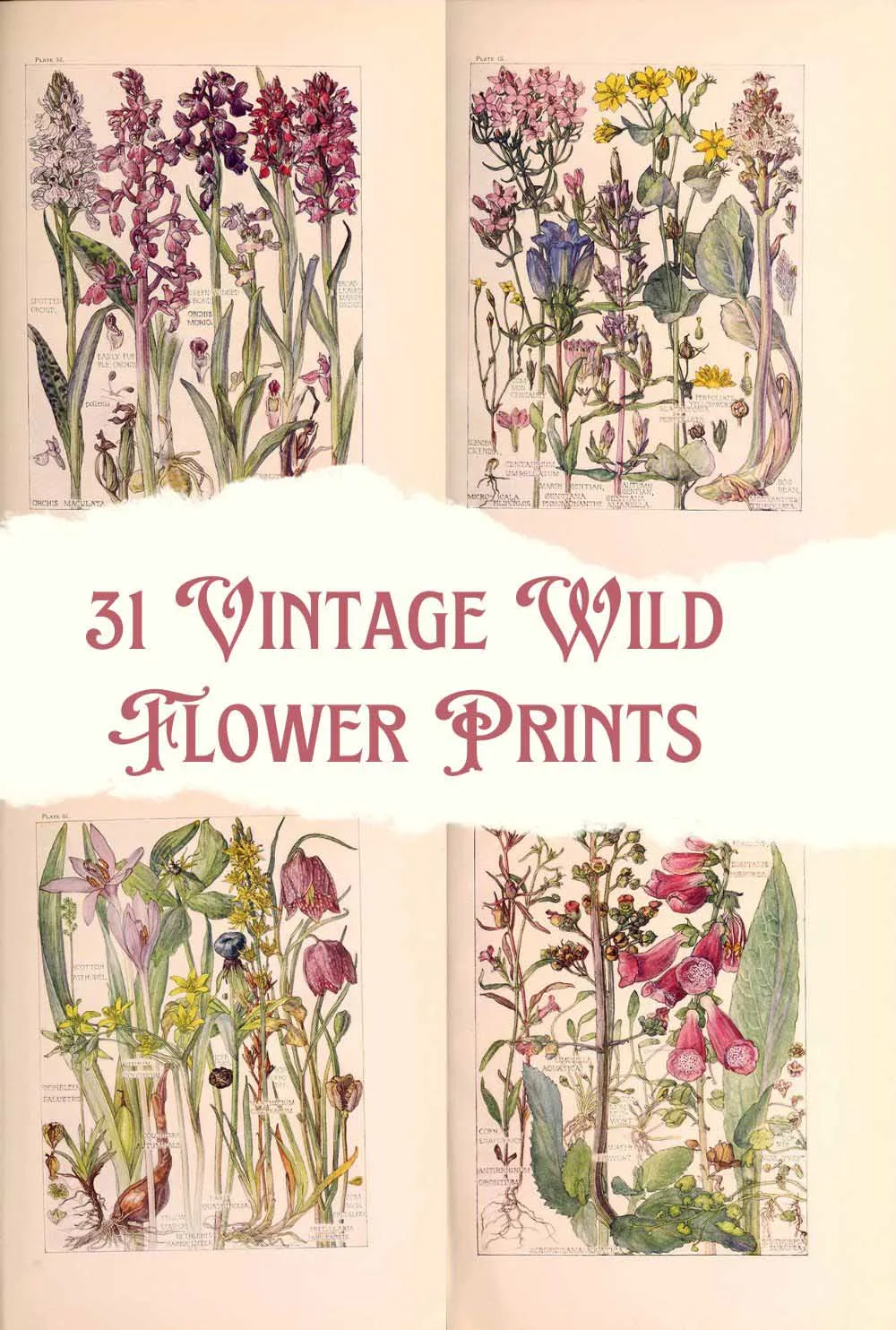
How To Print The Wild Flower Illustrations
All the vintage botanical floral illustrations of Harriet Isabel Adams are in the Public Domain, so you are free to download and use them how you wish.
To download a higher resolution image:
- Click on the title above the print you want
- It will open in a new window
- Right-click on that new image
- You will have the option to save or print the image.
Sample quotes about the wild flowers lifted straight from Harriet’s book (highlighted in italics).
I sourced the book from the McClean Library at the Pennsylvania Horticultural Society.
1. Bell Flowers Plate 1.
“The species native to our isles are all blue or white, but in foreign countries, brightest blue, purple, scarlet, and yellow run riot.
Many of these species are cultivated in gardens and greenhouses, such as the scarlet and blue Lobelias, as well as various kinds of Bell-flowers (Campanulas). The stems and roots of this order abound in a milky or acrid juice, usually harmless, which in some of the more powerful foreign species is employed as a medicine, and in the Lobelia genus is a venomous poison. The roots of the Rampion (Campanula Rapunculus) were cultivated as a vegetable.“
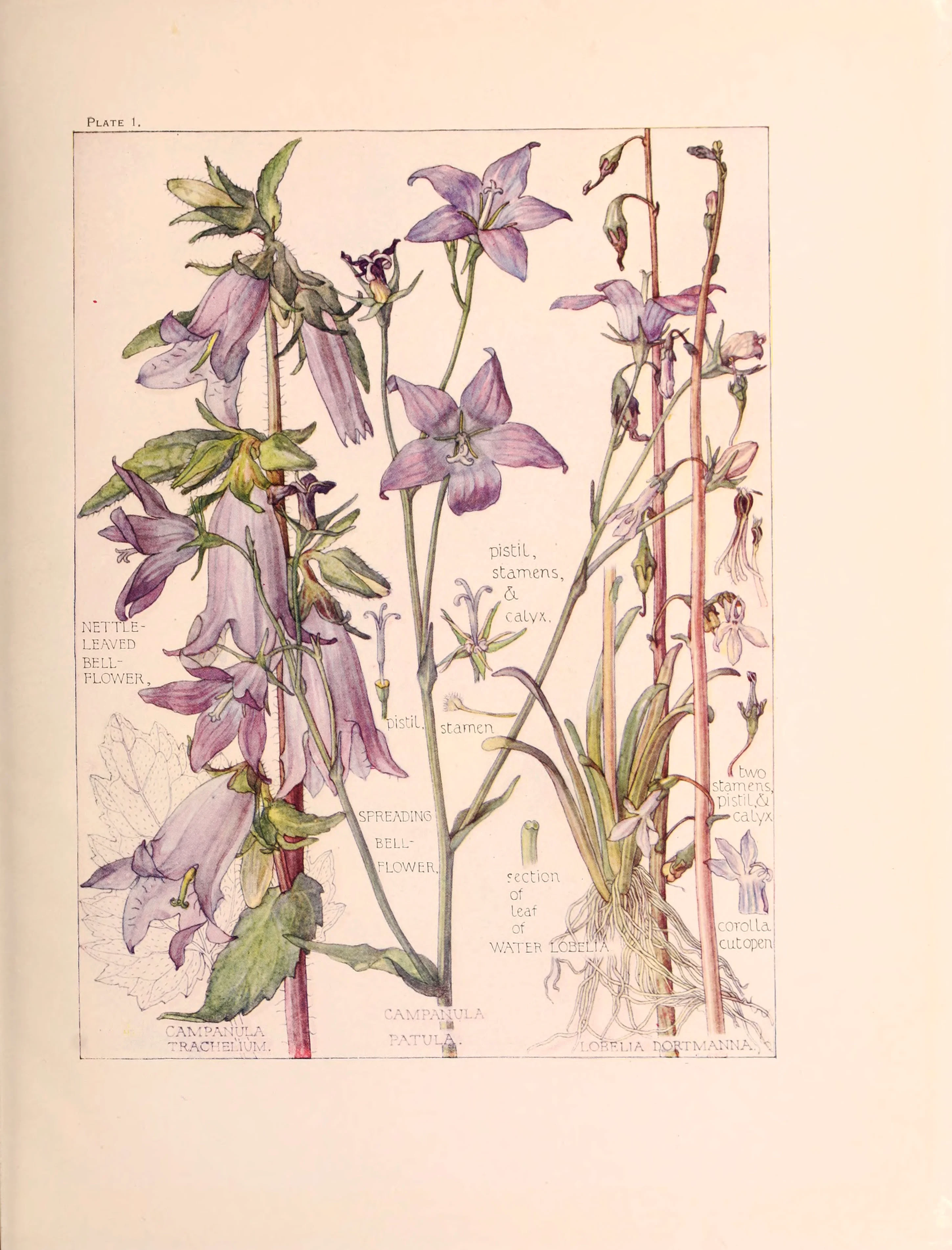
2. Bell Flowers Plate 2
More beautiful bell flower illustrations.
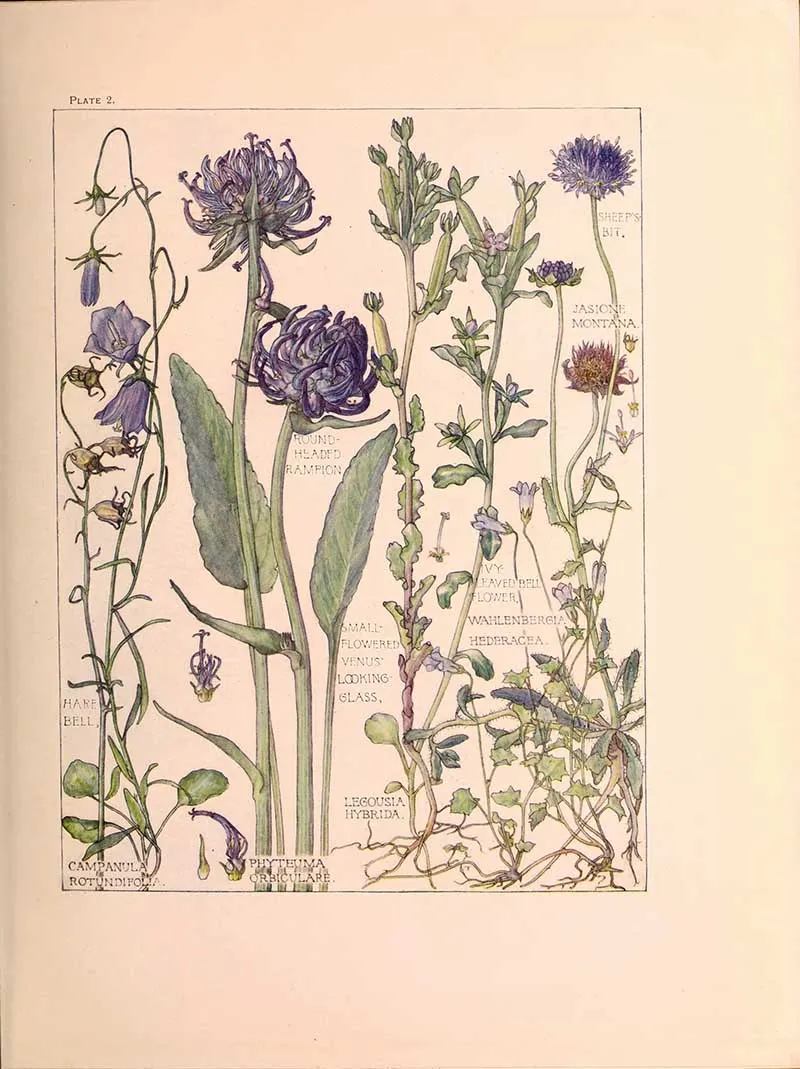
3. The Cranberry Family
“Members of this family are to be found in all quarters of the globe; those in the British Isles are all dwarf shrubs, but in other countries, there are tall trees. The species found in the British Isles, and in fact in all temperate zones, thrive in peat bogs and in the decaying vegetable matter of woods and heaths, and frequently have what is botanically called “ a social habit,” meaning that many plants of the same species grow together and often cover considerable areas of ground.“
Cultivated for their tasty fruit berries and not their beauty. Written next to the floral illustrations are some detailed descriptions.
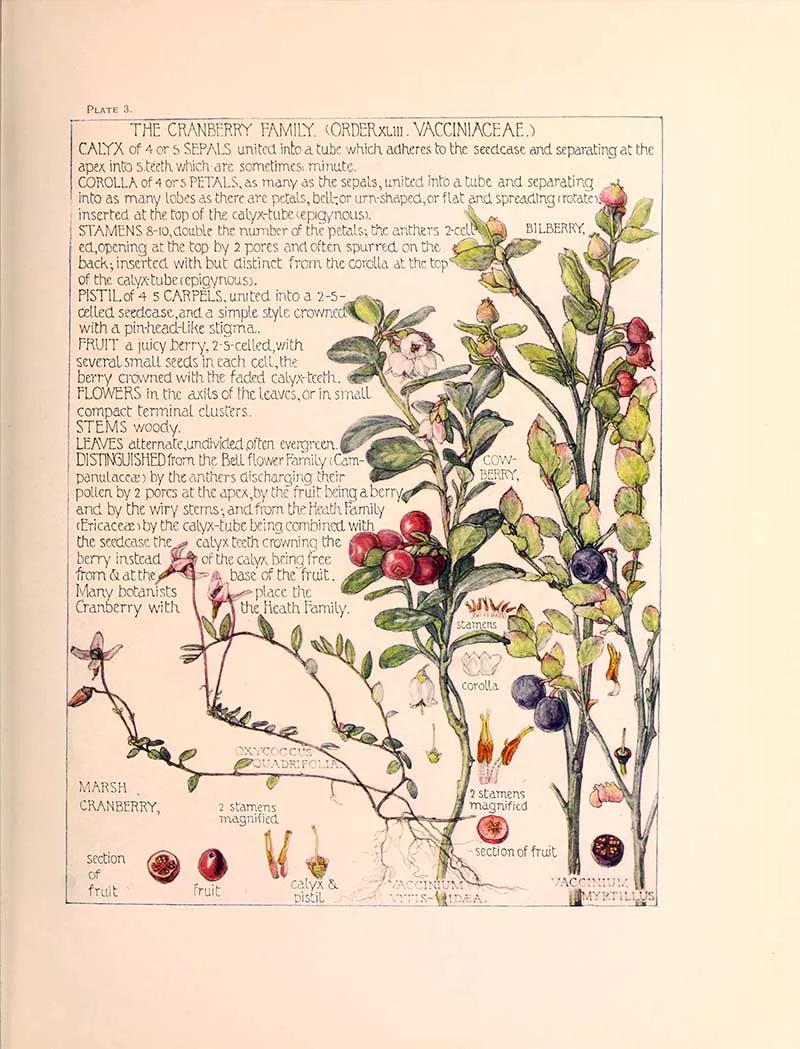
4. The Heath Family
“Except for the beauty of the flowers, very few members of this family have any special value. Some species of Kalmia and Azalea possess poisonous narcotic properties; in fact, the very honey of the Trebizonde bees that feed largely on Azalea pontica, and the Canadian partridge that feeds on the berries of certain species of Kalmia, are both said to be poisonous to human beings.“
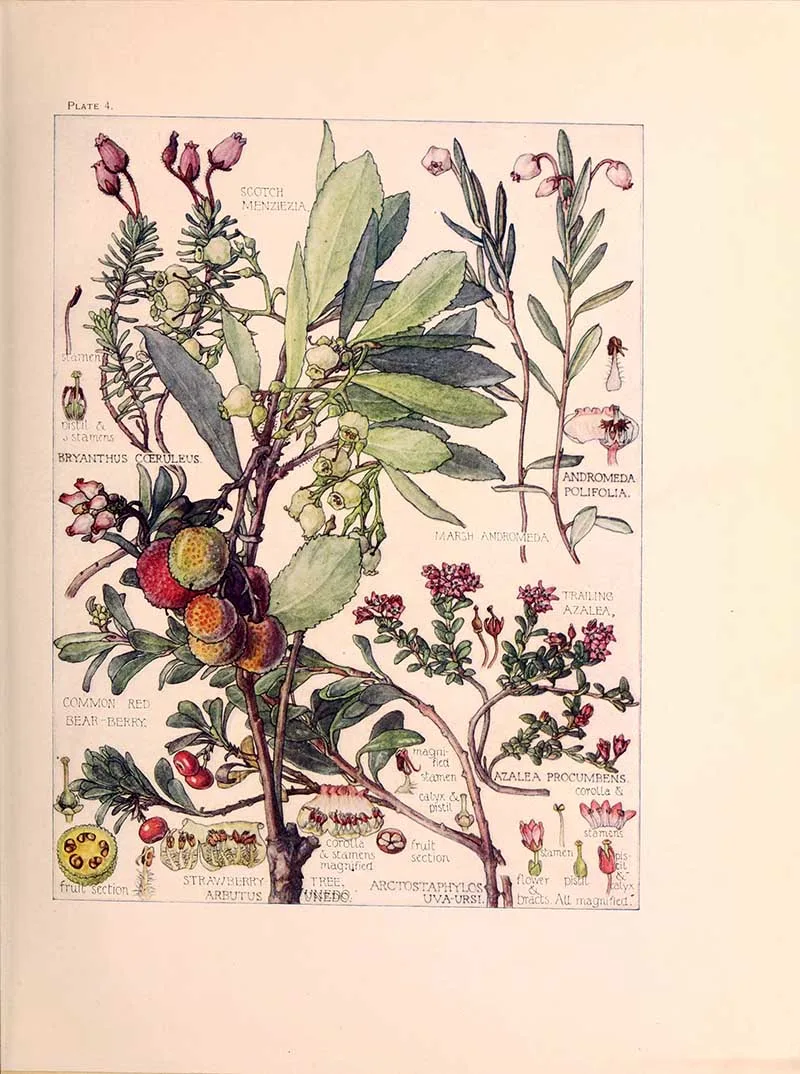
5. Heath Family Wild Flower Illustrations
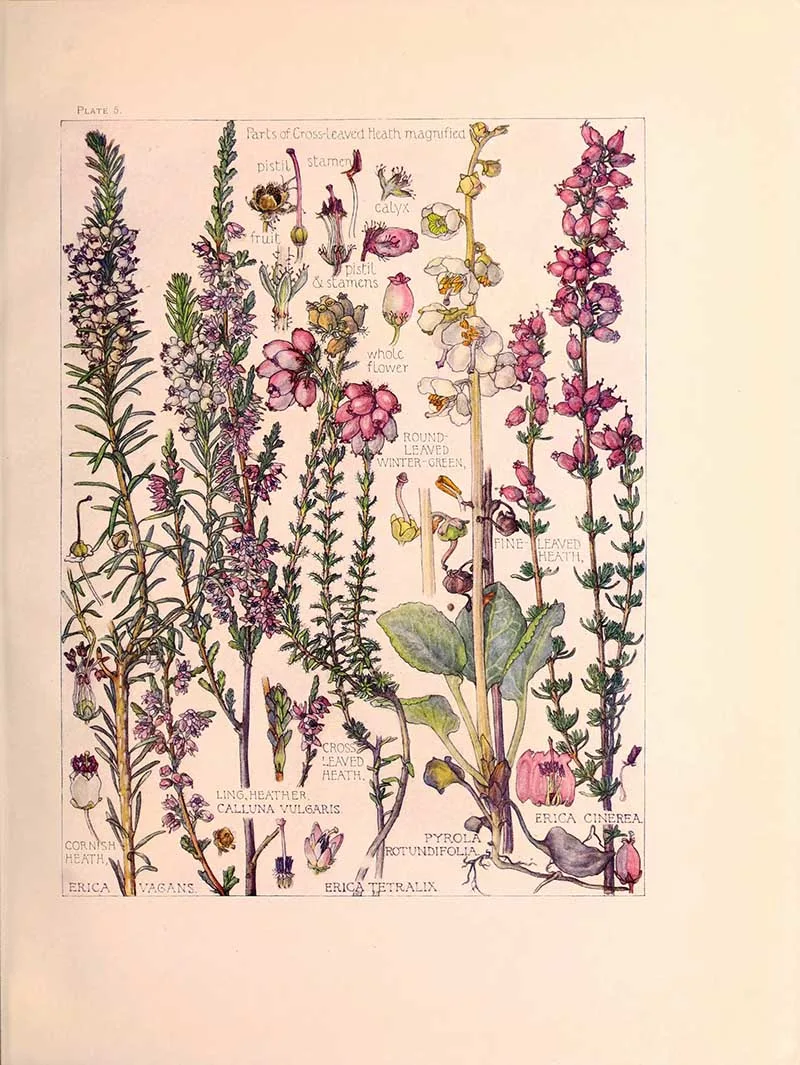
6. The Primrose Family
“Its members inhabit the temperate zones of the Northern Hemisphere, and though some of the species are so well known in our own isles, it is in Alpine districts that the order is seen to best advantage. High up in the Alps, Pyrenees, and Himalayas, on the bleak mountainsides, protected by the snow from the icy cold of winter, they blossom forth in the summer sun into a blaze of yellow, violet, mauve, pink, blue, and white. There species of Primula, Soldanella, Aretia, and Androsace abound in the glory of perfection.“
This collection of vintage flower fairy prints features a primrose illustration.
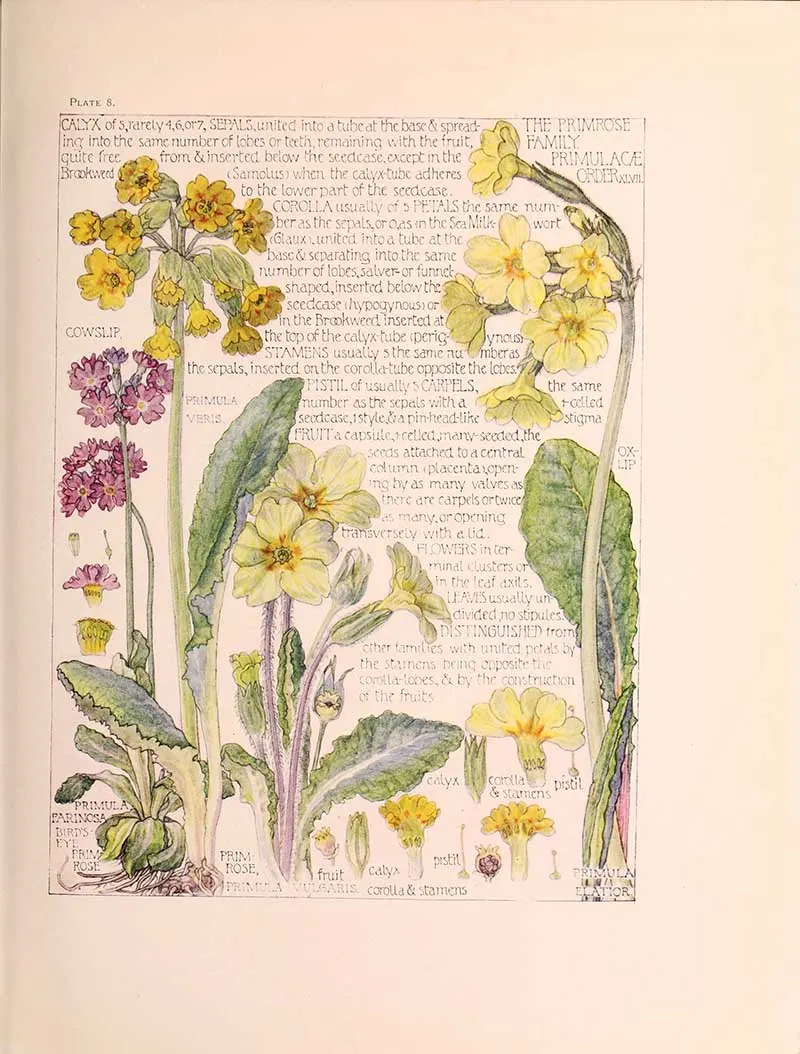
7. Primrose Family – Lilac Wild Flowers
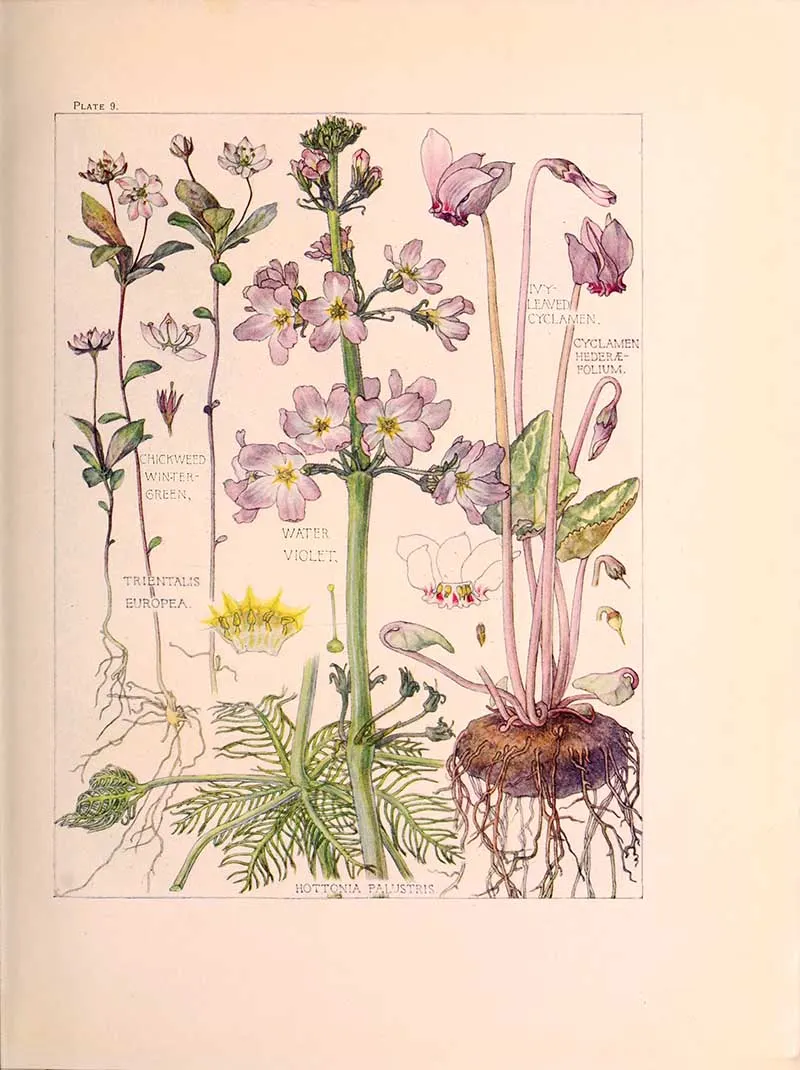
8. The Gentian Family
“Many species of Gentian are cultivated in rock gardens, but they are difficult to rear unless well shielded from cold north and east winds. Most of the members of the order are extremely bitter and some are employed in medicine as tonics.“
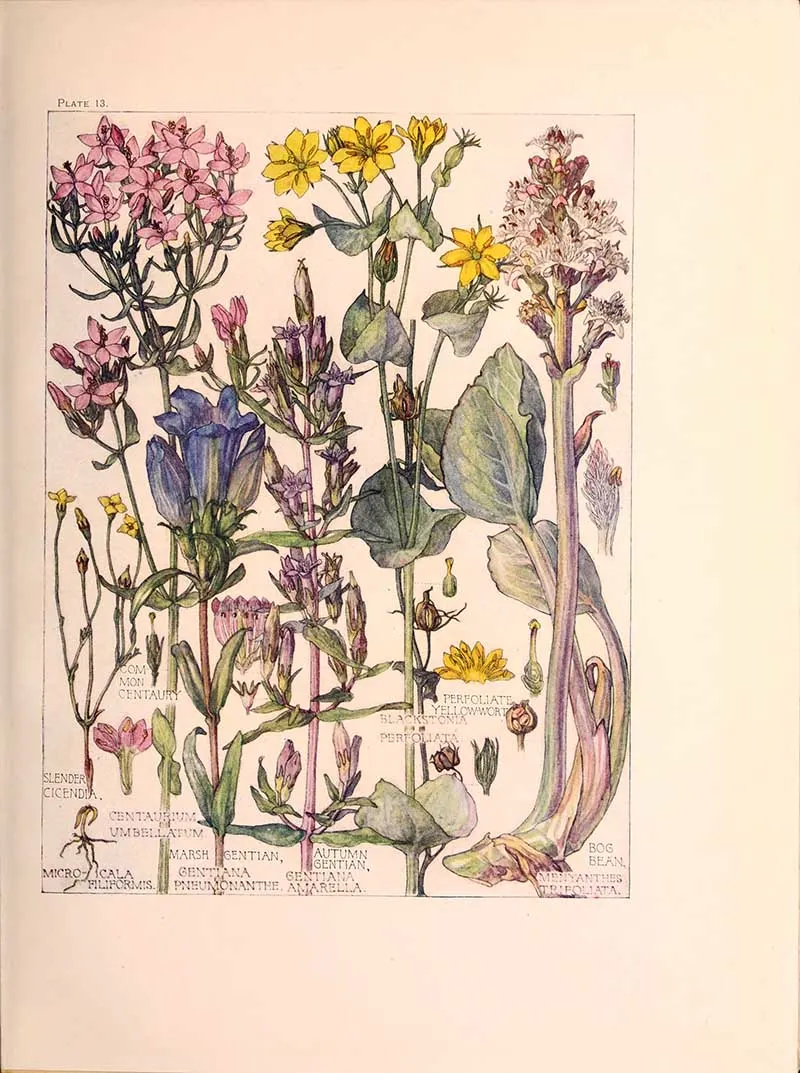
9. The Borage Family
“The Borage Family is one of the largest and most natural orders we possess. It is easily recognised by the spirally coiled clusters of flowers, which are usually blue, by the five stamens, by the 4-seeded fruit, and the entire rough leaves and succulent stems which are covered with harsh hairs.“
More beautiful wild flower illustrations with written description details.
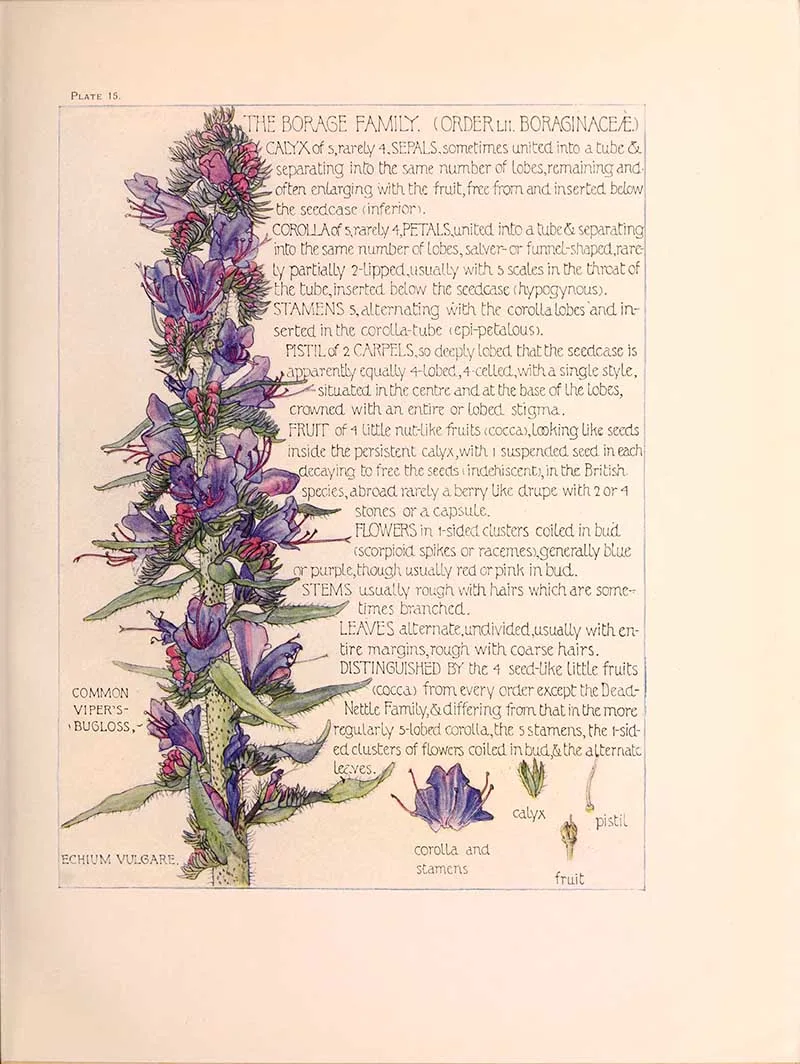
10. Borage Family Flower Plate 2
More illustrations and drawings of flowers from the Borage family.
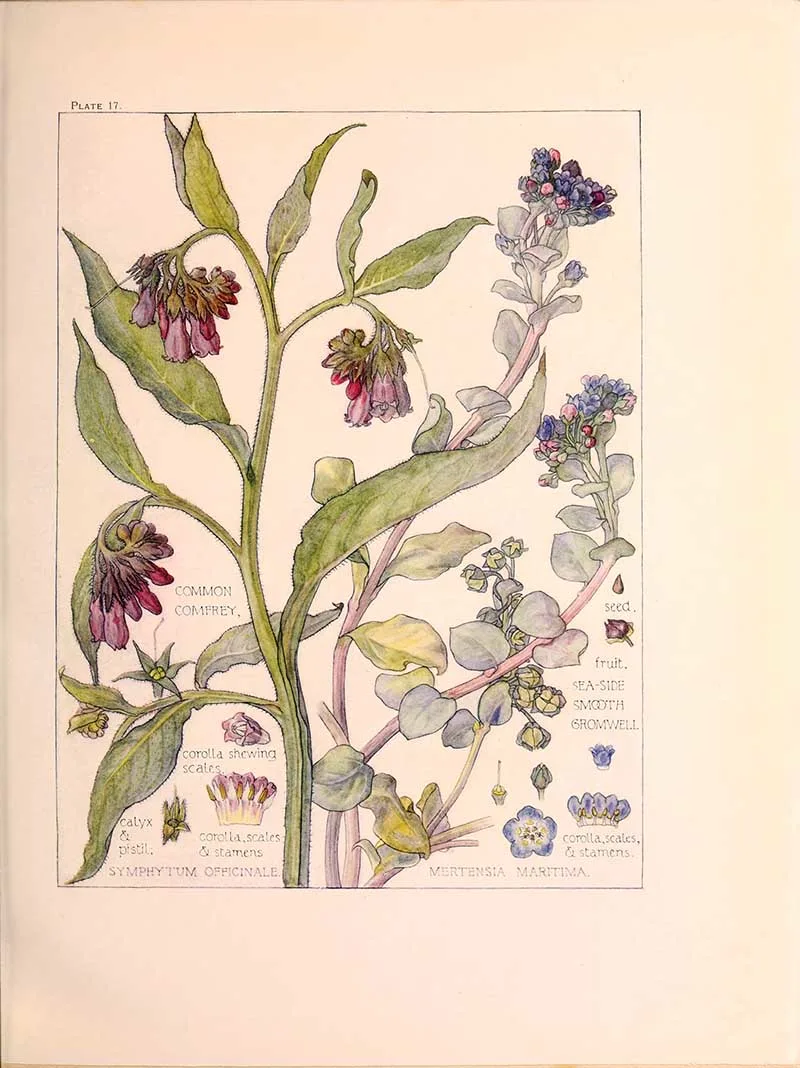
11. The Convolvulus Family
“Most of its members are climbing plants with heart-shaped leaves and large beautiful flowers which are often trumpet-shaped, though some are thread-like parasites with small dense heads of waxy, unpleasant scented flowers.“
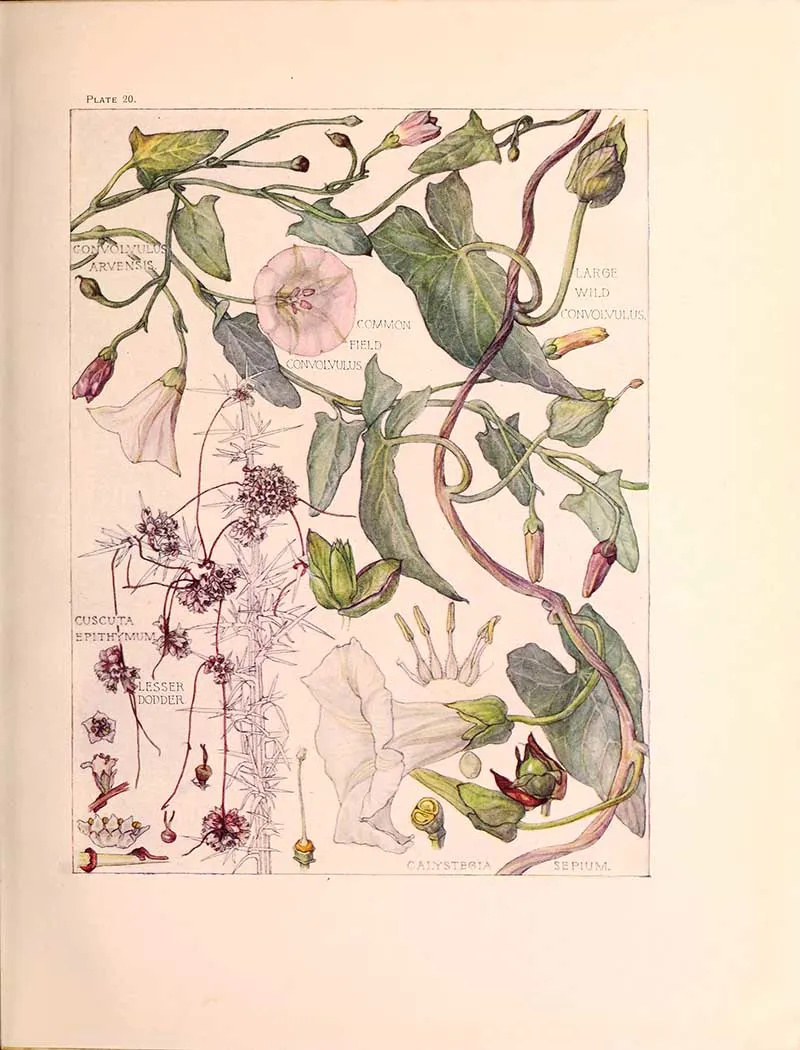
12. The Nightshade Family
“An interesting member of this family is the mandrake (Mandragora officinalis), concerning whose roots the fable was told that they shrieked if torn from the earth.“
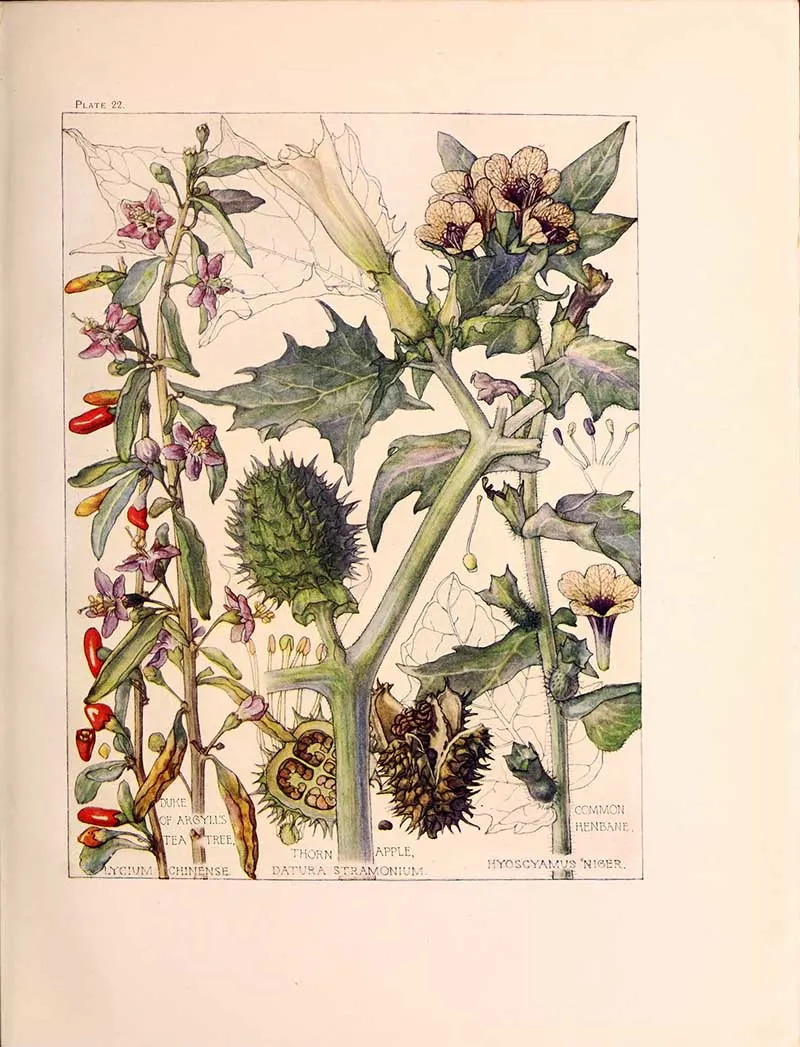
13. The Figwort Family
“Some species have strong medicinal properties. Extracts from the Foxglove (Digitalis) and from certain species of Mullein (Verbascum thapsiforme and Verbascum phlomoides) are included in the pharmacopoeia.”
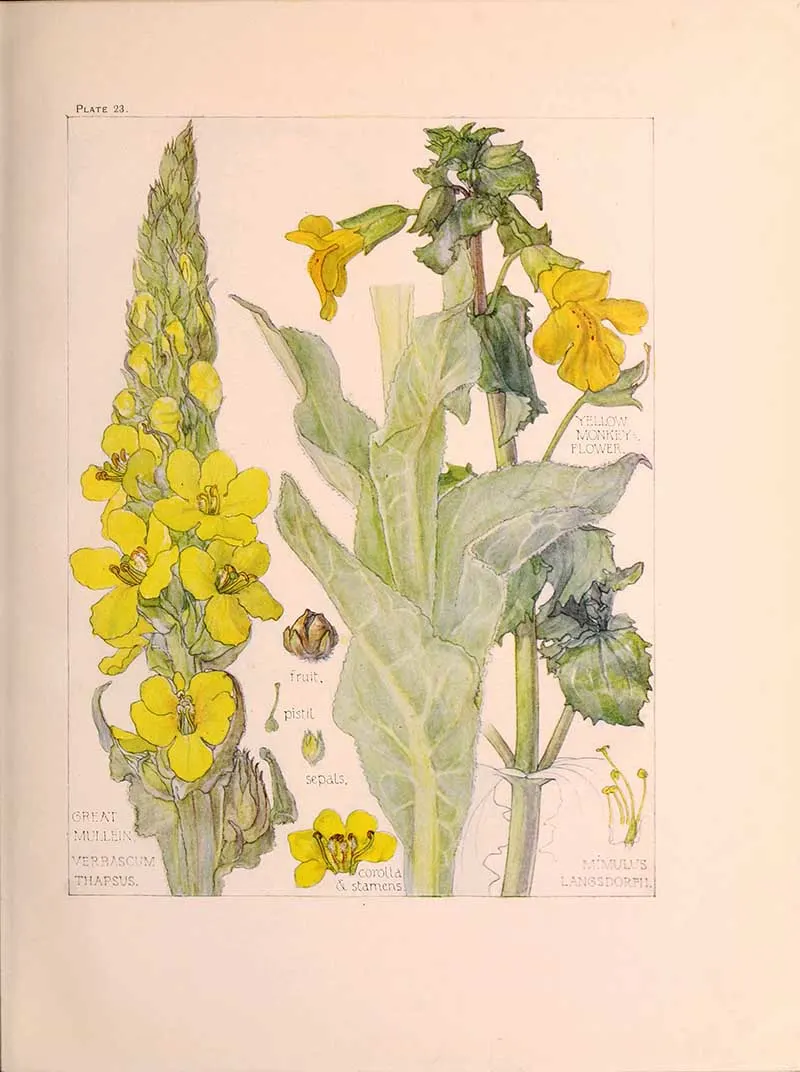
14. Figwort Family – Foxgloves
The Foxglove plant has medicinal uses but is also very toxic to humans and other animals, and consumption can even lead to death.
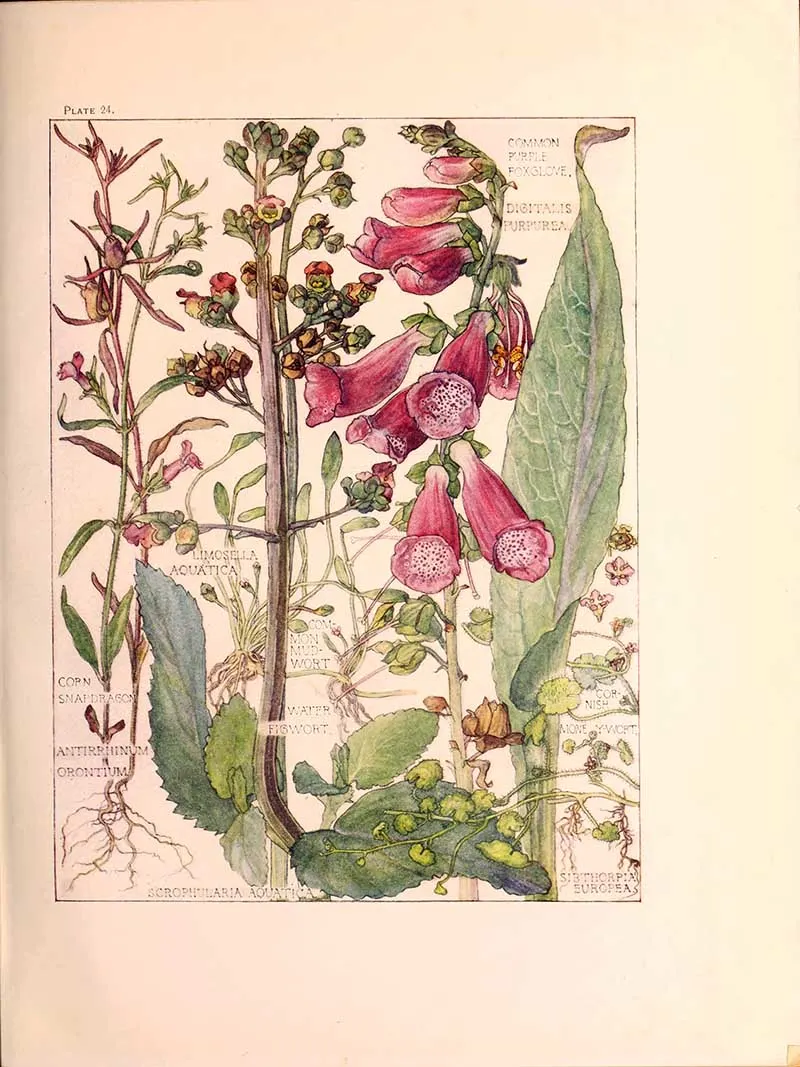
15. Figwort Family – Speedwell
Speedwell flowers are typically weeds found on garden lawns. It can be not easy to distinguish one species from another.
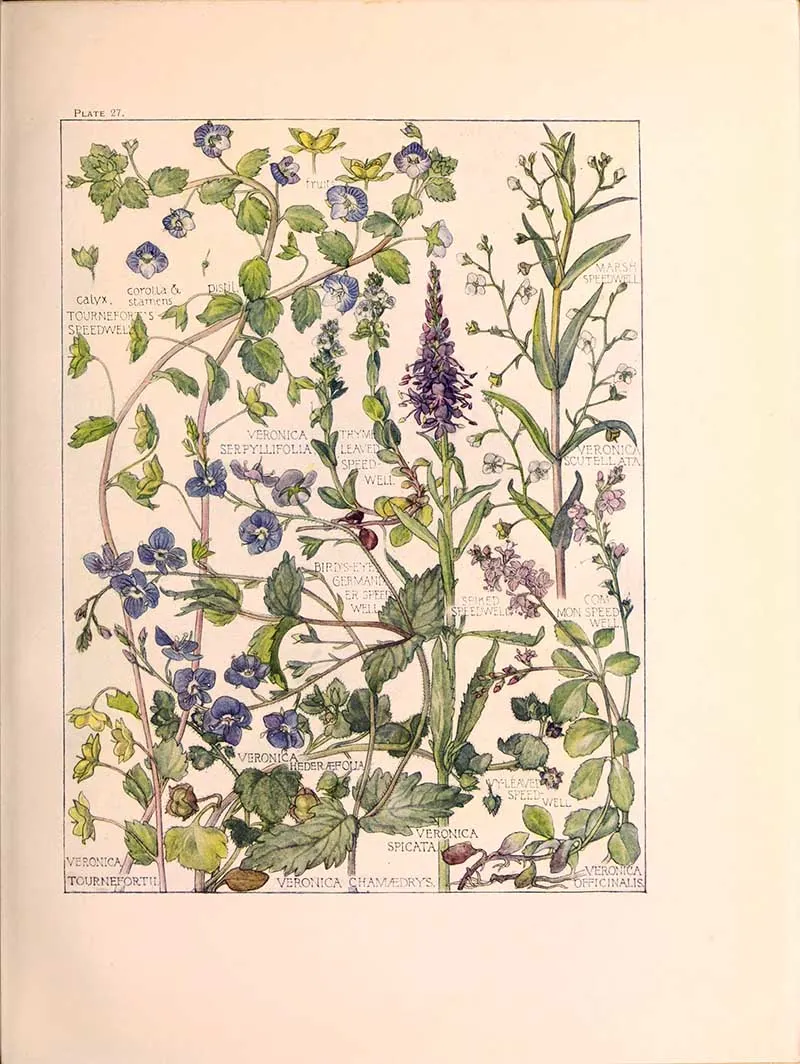
16. Butterwort Family
“All the members of this order are bog or water plants. The two genera native to the British Isles are both carnivorous. One captures its prey by means of sticky glands on the surface of the leaves and the other by small bladders borne on the leaves which are all submerged.“
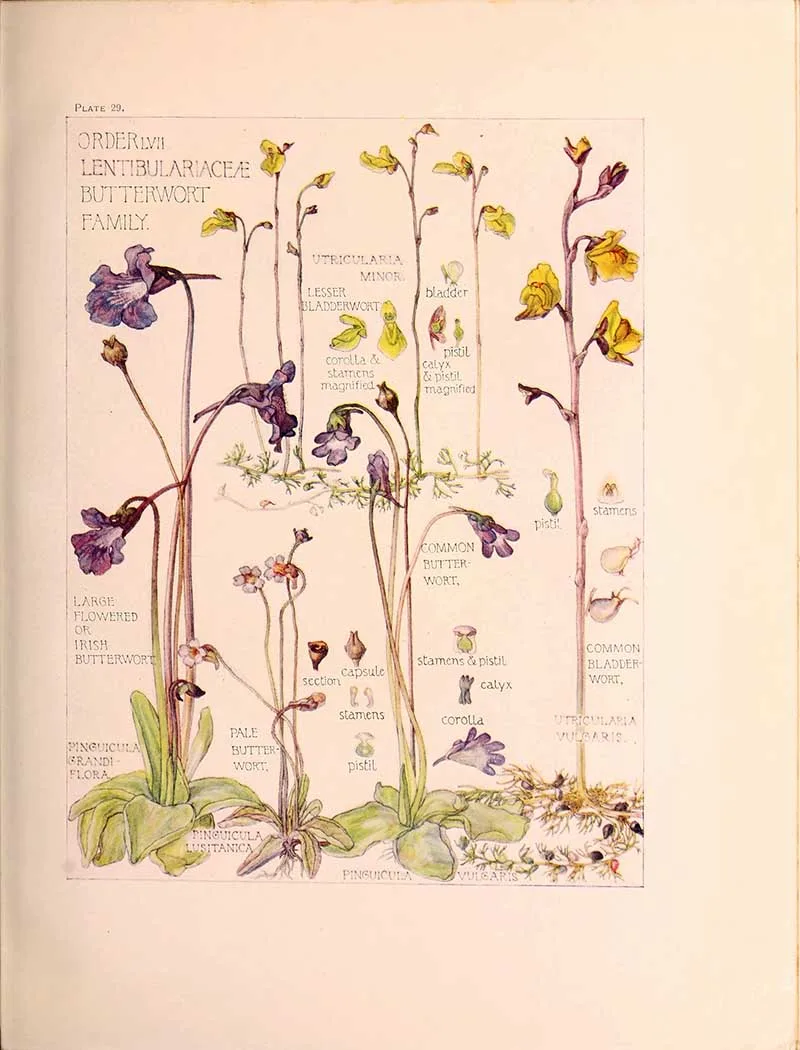
17. Dead Nettle Family
Many of these plants are pleasantly fragrant and cultivated as herbs:
- Basil
- Mint
- Rosemary
- Sage
- Savory
- Marjoram
- Oregano
- Hyssop
- Thyme
- Lavender
- Perilla
- Catnip
White Dead Nettle family of wildflowers with Harriet Adams’ descriptive text. You can cook and eat salads with the young leaves of this plant. Known as bee nettles, the nectar and pollen of the flowers are popular with bumble bees.
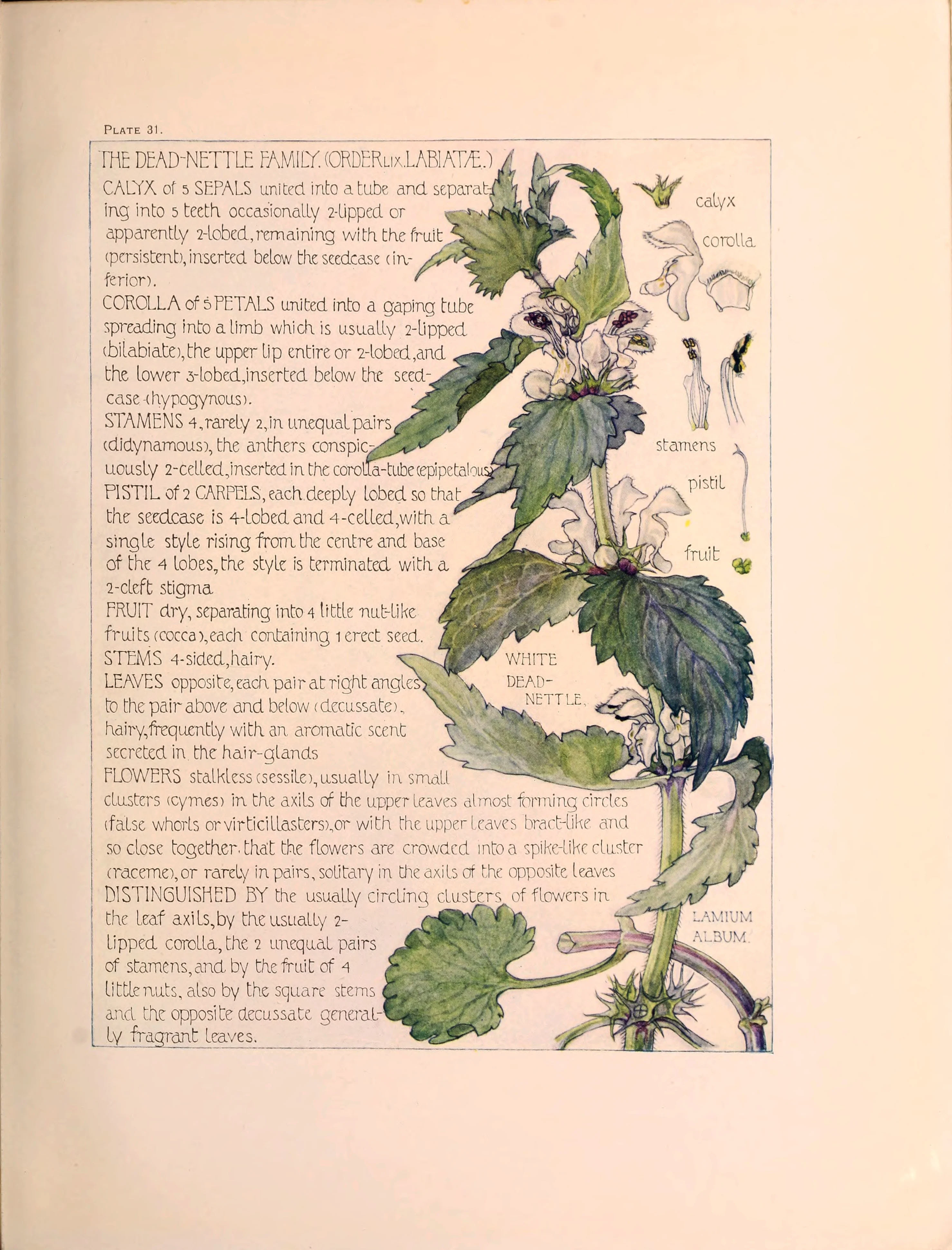
18. Dead Nettle Family – Red & Yellow
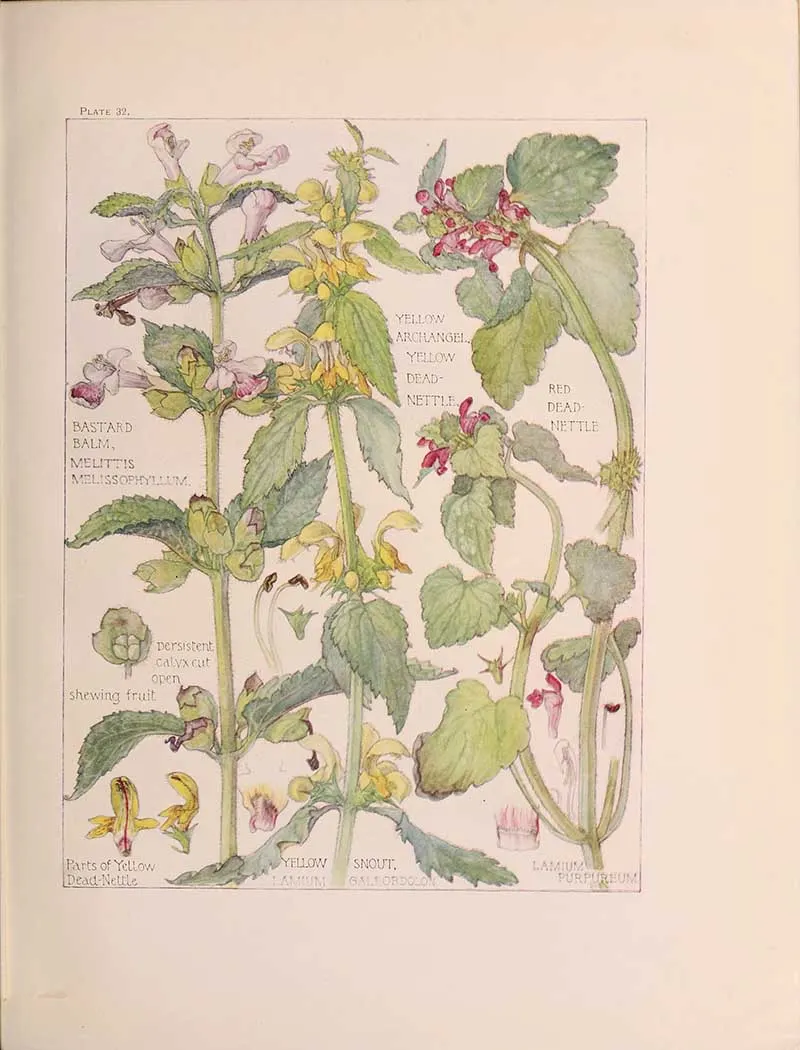
19. Dead Nettle Family 3
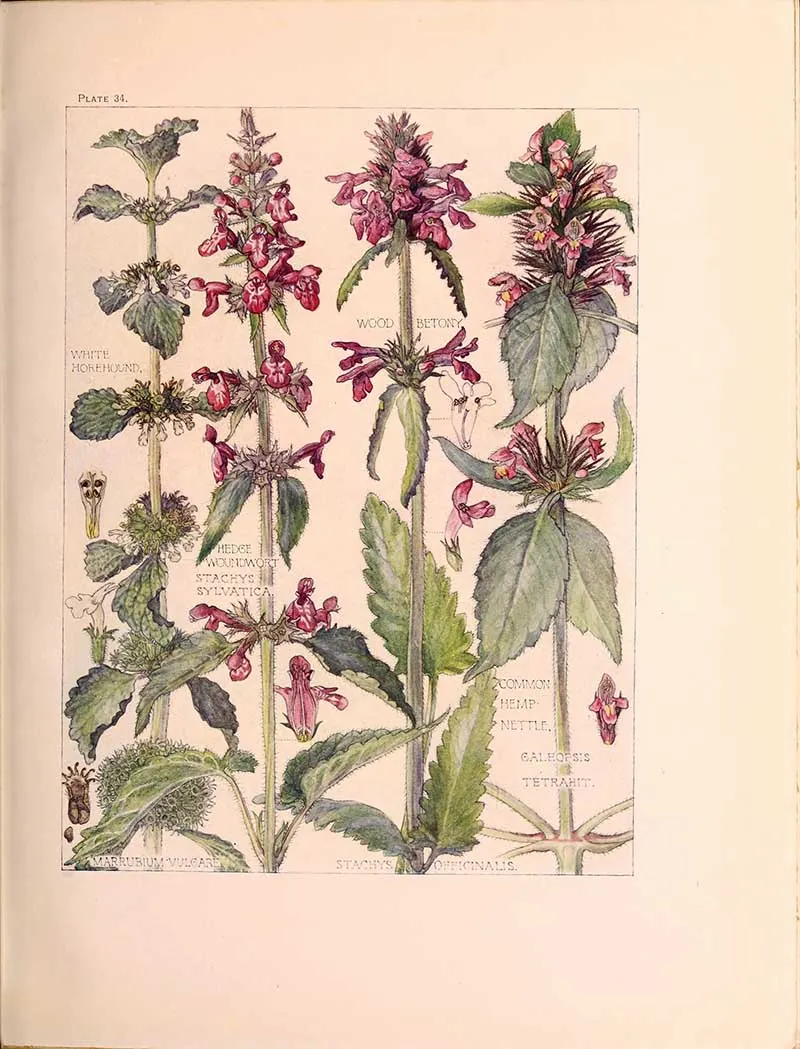
20. Dead Nettle Family Flowers 4
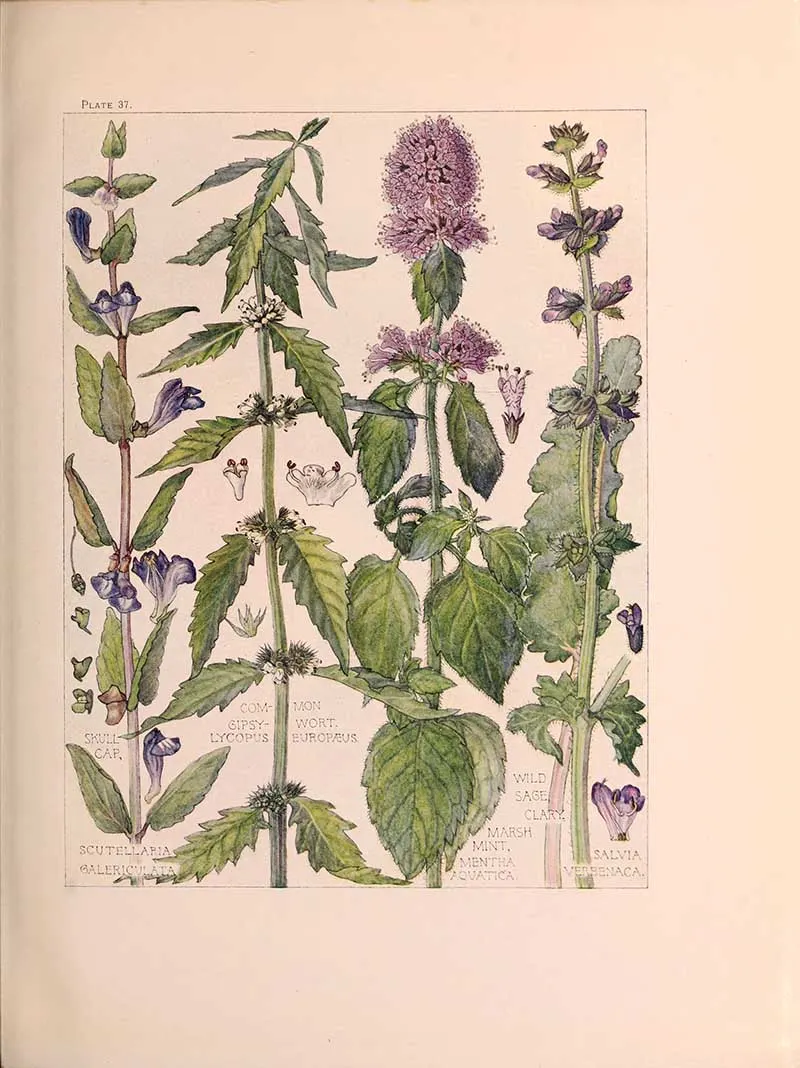
21. Persicaria Family
“The stalks of the Rhubarb (various species of Rheum) are much used for tarts, and Sorrel (Rumex Acetosa) is cultivated as a vegetable in some countries. Buckwheat (Fagopyrum sagittatum) is grown as a food for pheasants. Though the stalks of the Rhubarb are pleasant eating when cooked, the roots are very different; those of Rheum officinale and Rheum palmatum, however, being valuable in medicine.“
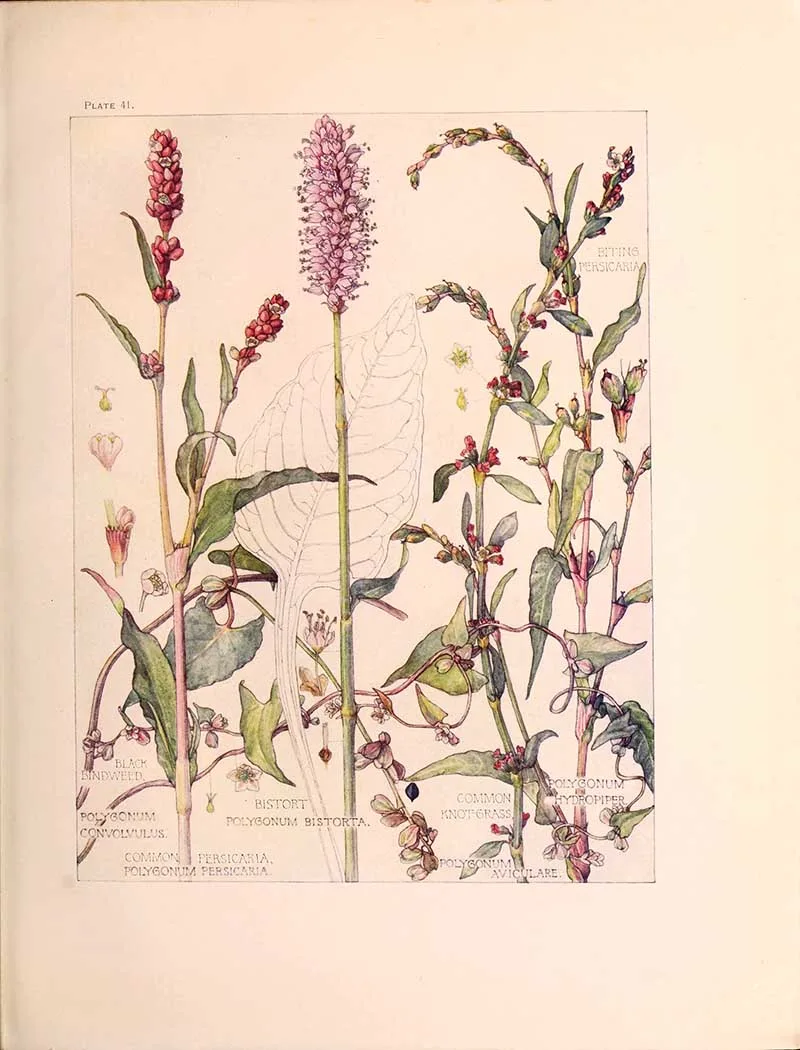
22. Persicaria Family 2
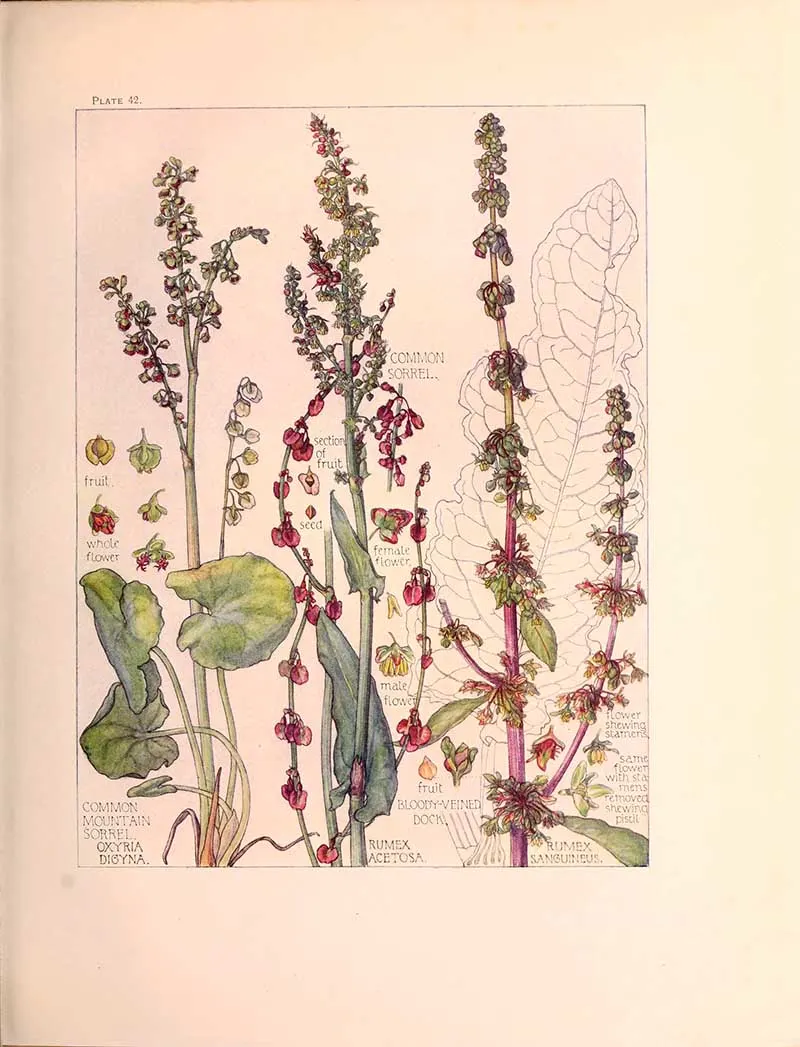
23. Birthwort Family Flower Illustrations
“The Virginian Snake-root (Aristolochia serpentaria) is used as an antidote to snake bites, and several species are said to have properties which stupefy snakes and so enable jugglers to perform their tricks with them.“
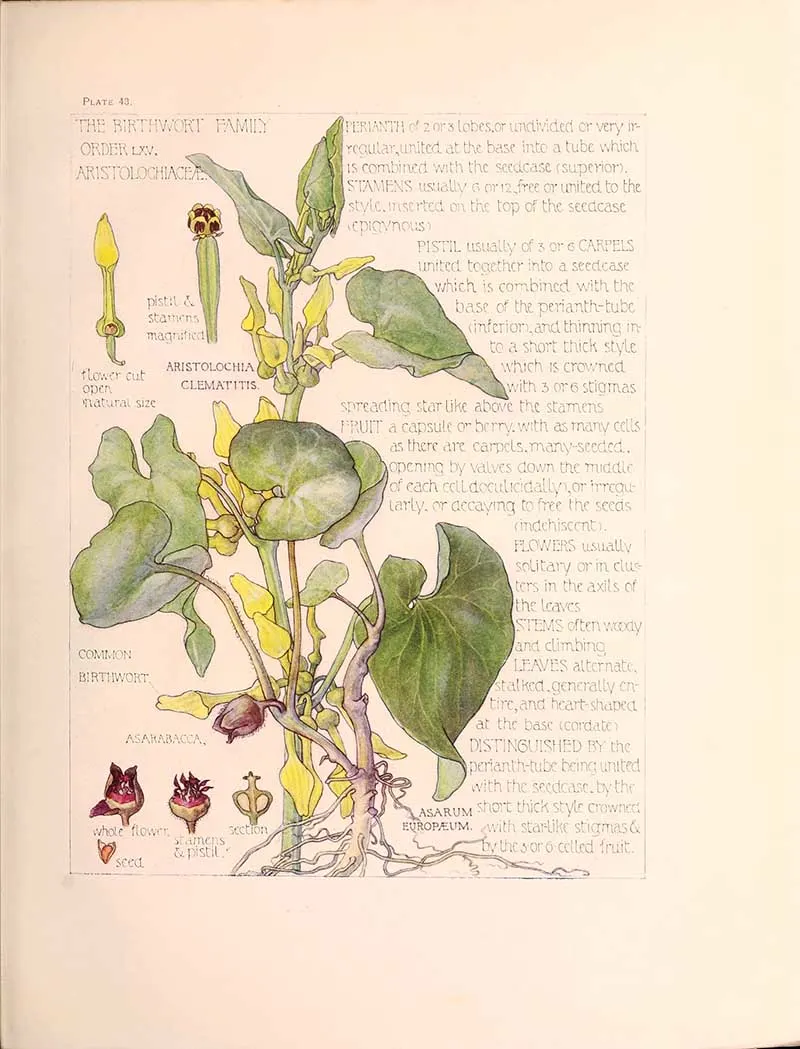
24. Spurge Family
“Many foreign genera are cultivated in greenhouses for the beauty of their flower-clusters, the best known being species of Euphorbia with clusters of flowers enveloped with gorgeous-coloured involucres, Poinsettias and Jatrophas with brilliant red bracts surrounding inconspicuous flowers, and Crotons with their coloured leaves.
Some genera are valuable commercially, the most important being species of the South American Hevea, from the milky juice of which we obtain India-rubber.”
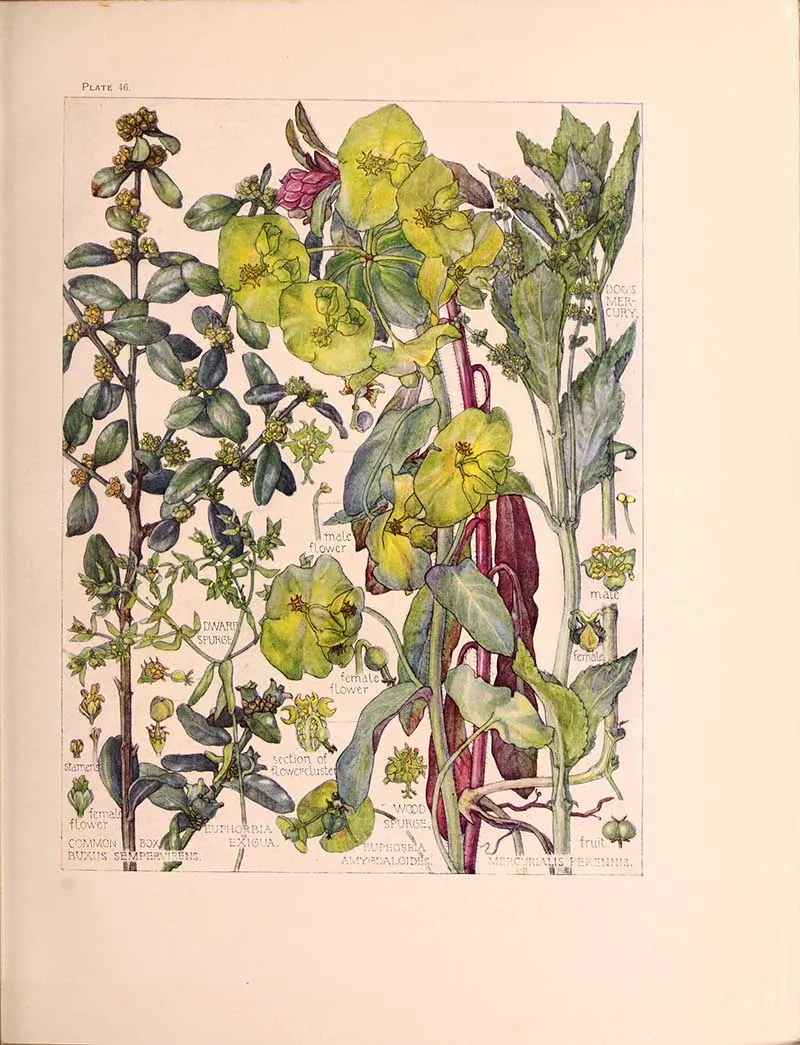
25 Orchid Family
“They have, of course, the wonderful construction peculiar to all orchids, and are so unlike the ordinary flower in appearance that they are frequently likened to animals, reptiles, and insects, as we may see by their names, the Monkey-, Frog-, Lizard-, Bee-, Fly-, Spider-, and Butterfly- Orchids.“
For more vintage orchid prints, check out those of Charles Antoine Lemaire.
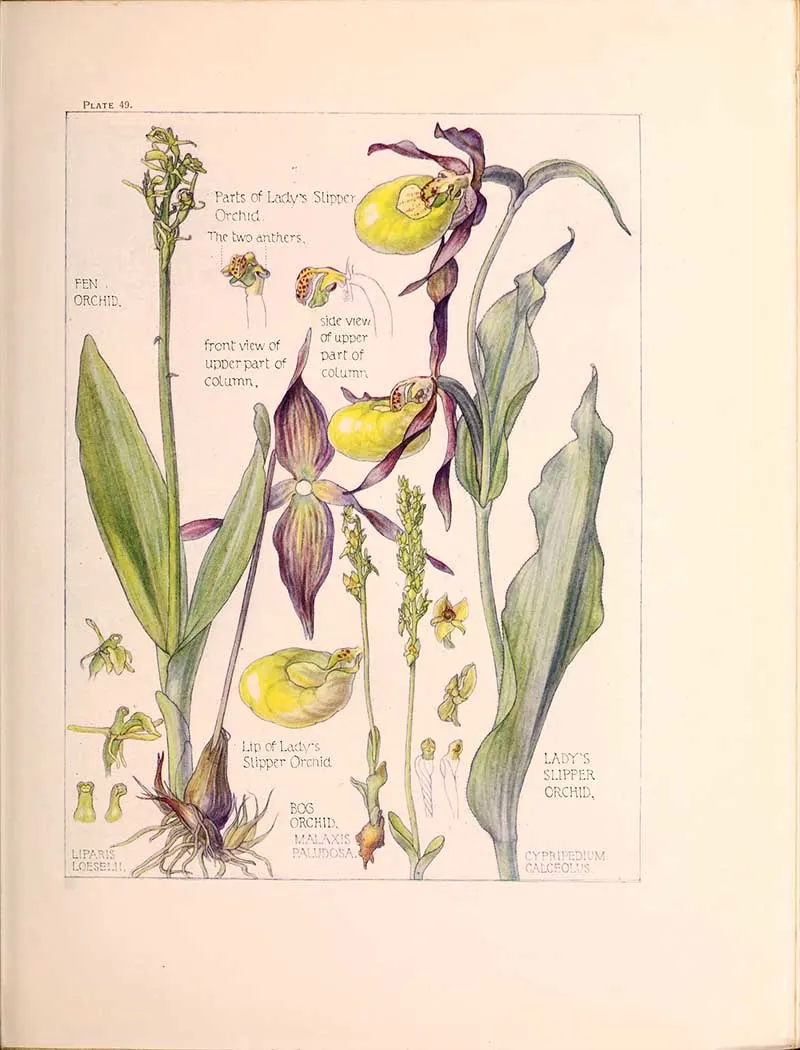
26. Orchid Family 2
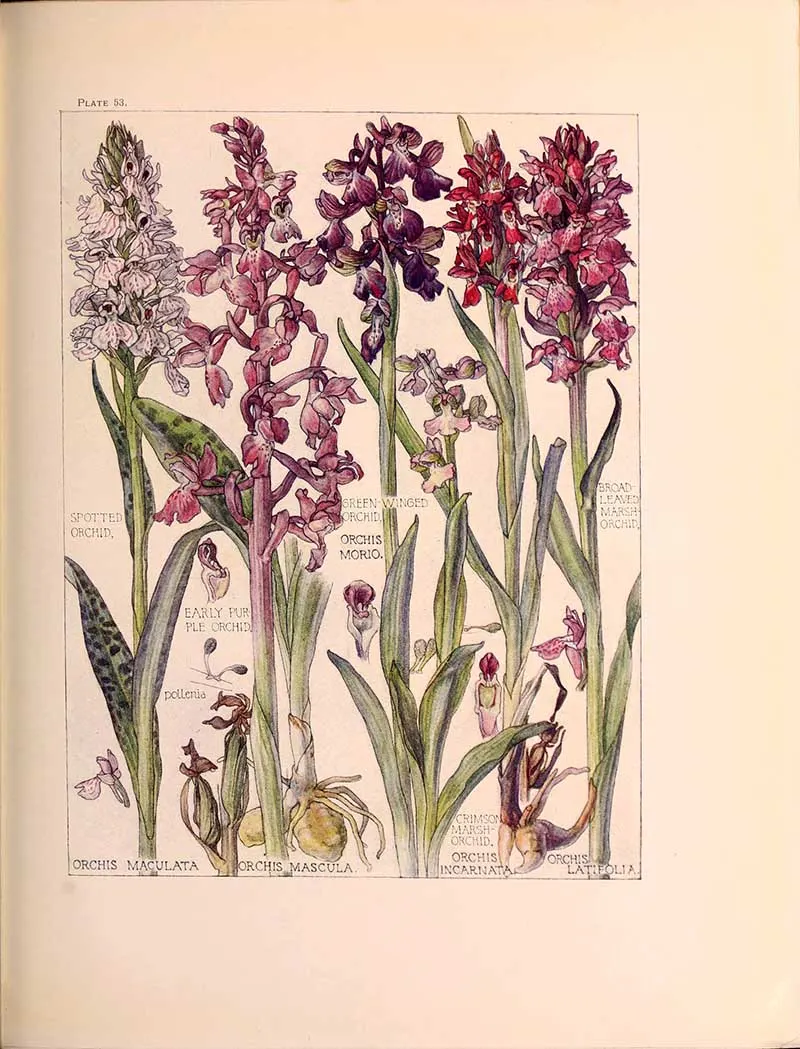
27. Iris Family
“One species of Crocus, the Saffron Crocus (Crocus sativus), has wide rolled-up stigmas which are so heavy that the style cannot hold them erect, and they hang like a tassel outside the flower. These stigmas, dried and powdered, are the Saffron used in cooking and dying. Orris-root powder, used in dentistry, is obtained from the roots of several species of Iris native to the countries bordering the Mediterranean.“
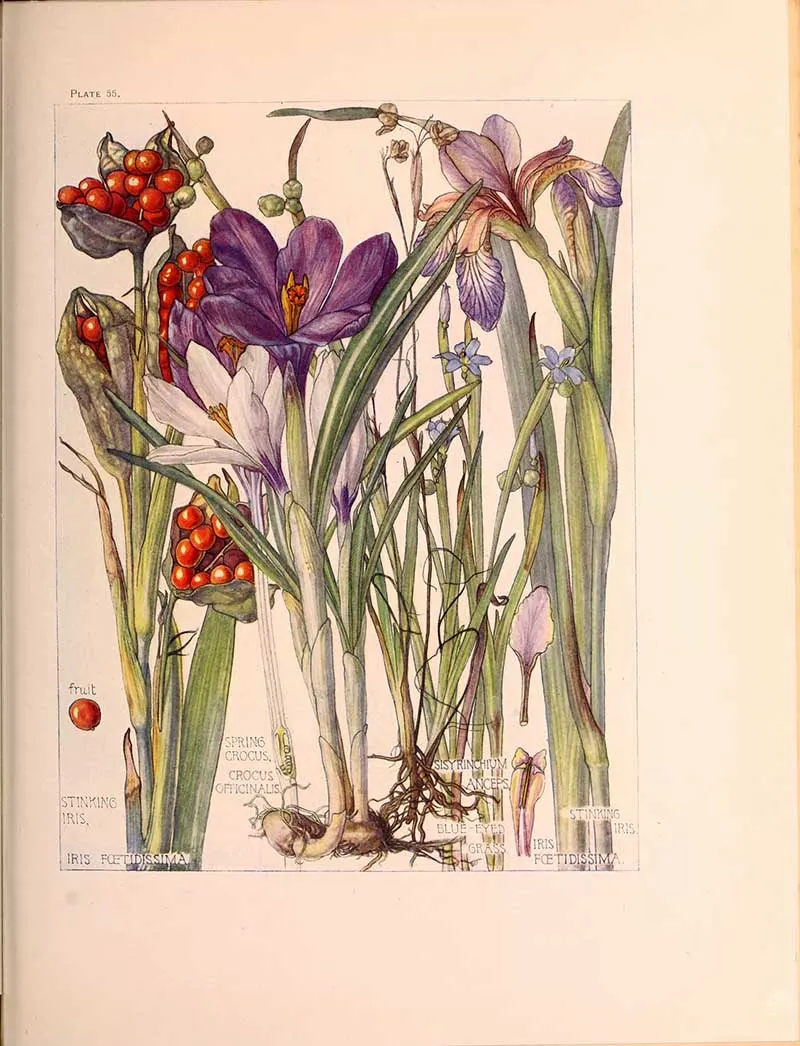
28. Amaryllis of Narcissus Family
“Various species of Narcissus, which we know as Daffodils, Narcissus, and Jonquils, are cultivated in gardens. The parent species of Narcissi from which varieties are obtained are natives of southern Europe and Asia. Snowdrops are common in every garden.”
The two wild flowers on this plate are ones that I see every spring in my local park.
This group features a detailed description of the wild flower illustrations, including this daffodil drawing. Additionally, I have an easy daffodil drawing tutorial available on the site.
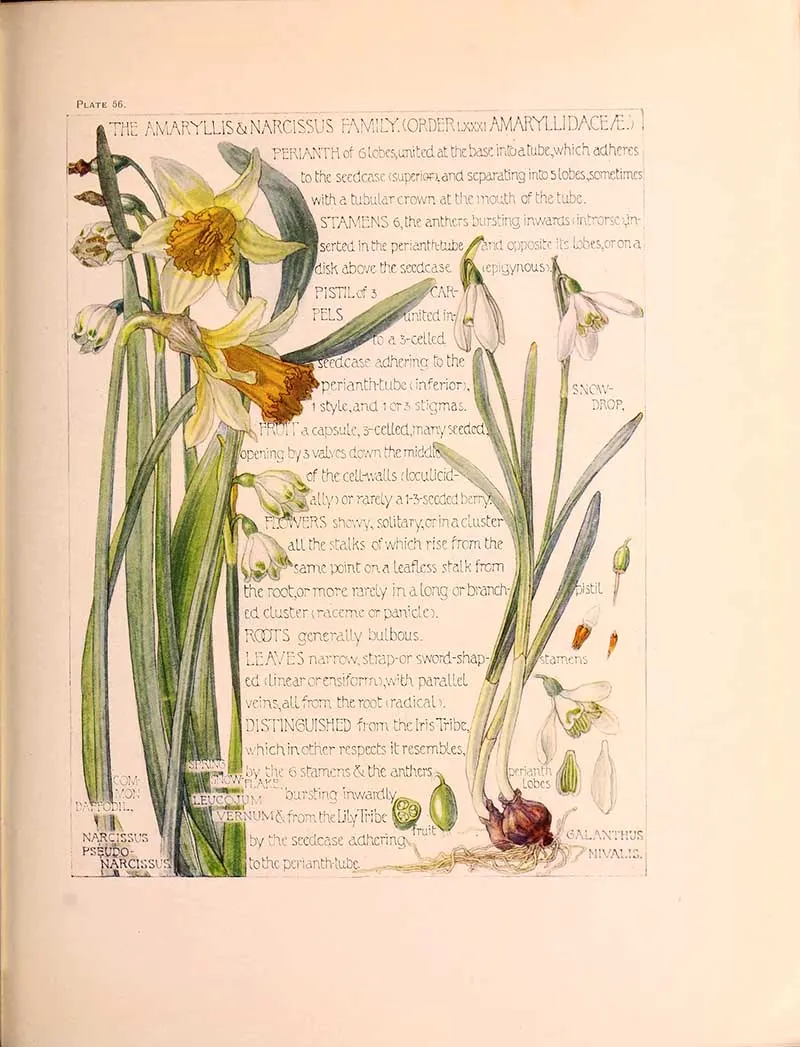
29. The Lily Family
“Many lovely flowers are cultivated in greenhouses and gardens. Some of the best known are various species of the Lily, Tulip, Hyacinth, Star of Bethlehem, Lily of the Valley, Tuberose, Trillium, Aloe, Yucca, Dog-tooth Violet (Erythronium), Red-hot Poker (Knipholia), the Day Lily (Hemerocallis), Smilax, and Aspidestra.”
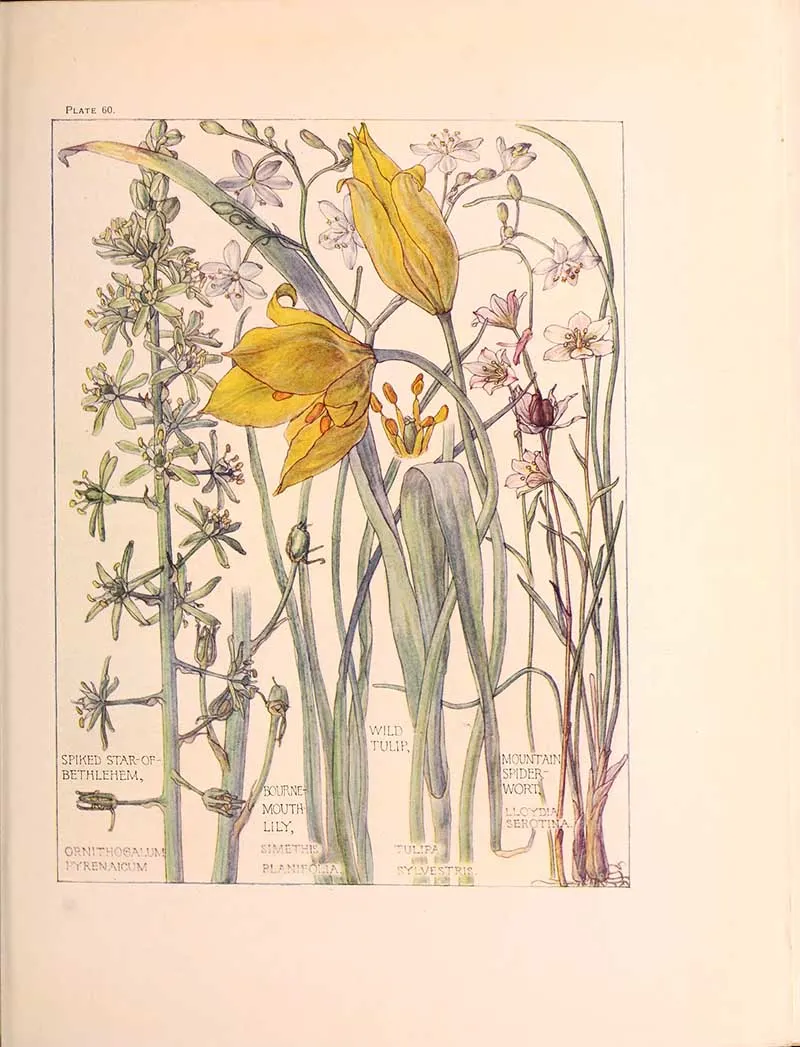
30. Lily Family 2
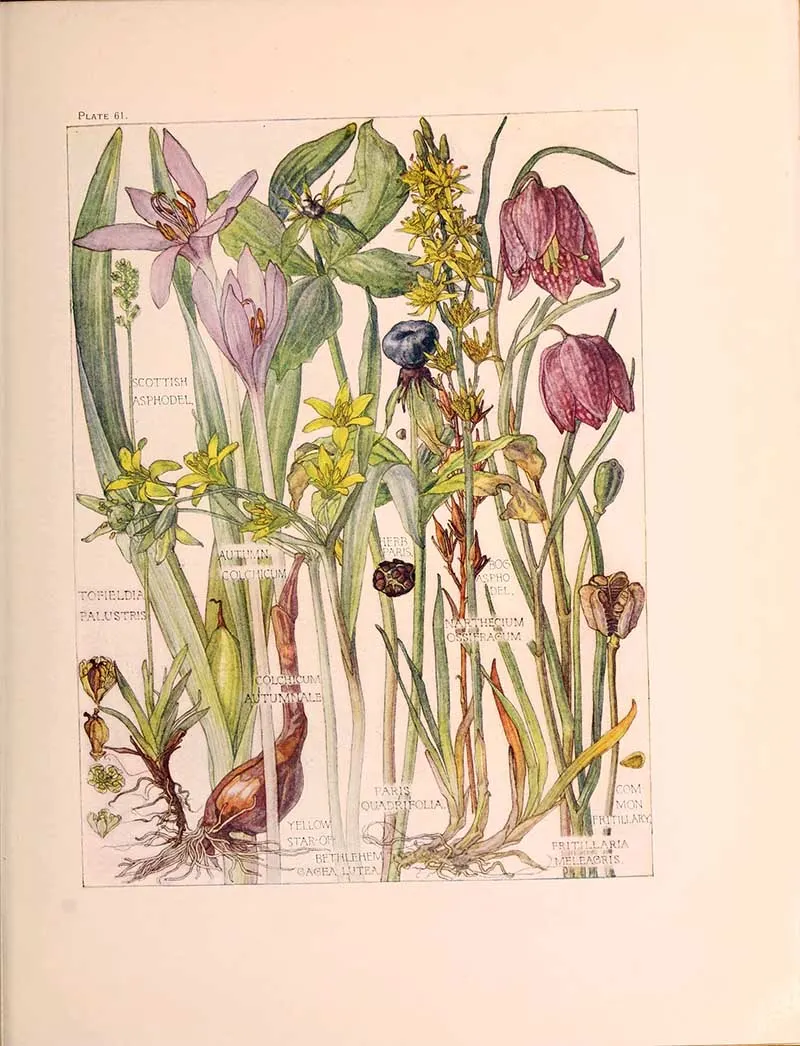
31. Arum Family
“The most remarkable member of the family is the Amorphophallus titanum, a native 01 Sumatra, an extraordinary plant with a huge tuber, umbrella-like leaves on stalks 9-14 feet high, and an enormous flower-cluster consisting of a spadix 9 feet high with a beautiful mottled green and purple sheath. This plant has flowered at Kew.“
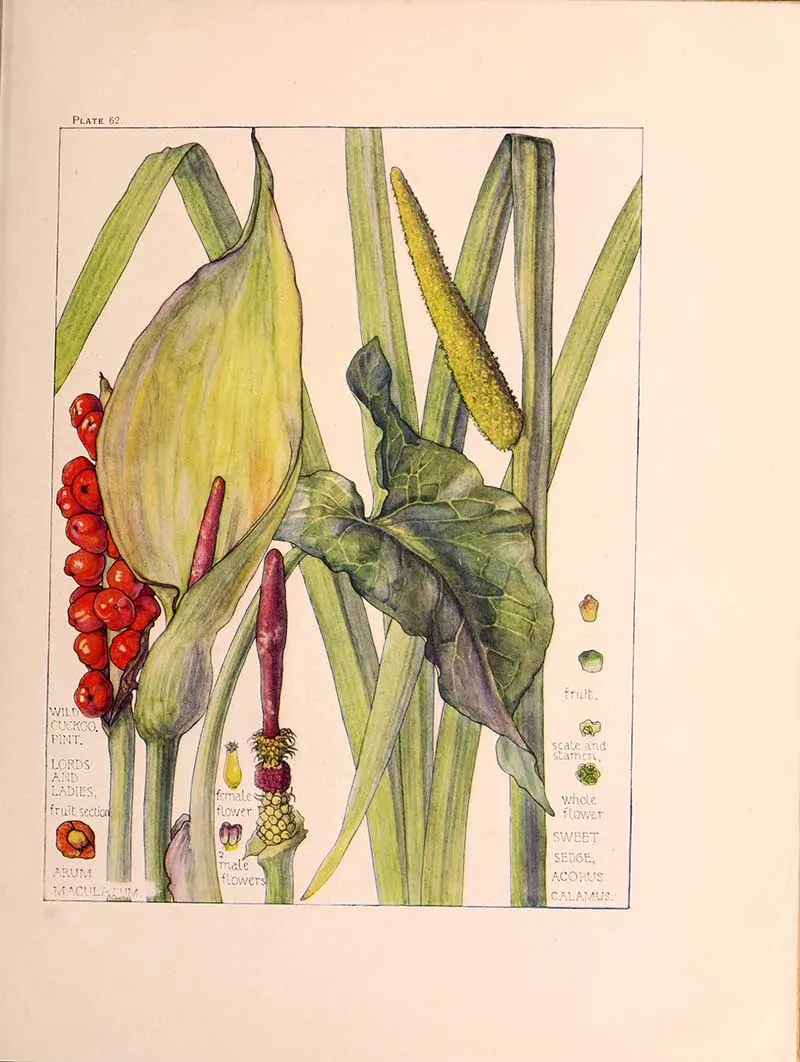
If you enjoyed these flowers, then I can assure you that you will love the collection of American wildflowers and the vintage watercolour flower paintings of Alexander Marshal in his florilegium. And the detailed vintage botany tables of Gessner’s.
Some of the other vintage flower artists you may want to check out are;
- John Thornton and his Temple of Flora
- John Lindley’s tropical botanical illustrations
- Pierre-Joseph Redoute flower prints
- Adolphe Millot vintage botanical posters
- Elizabeth Blackwell, “A Curious Herbal“,
Plus these beautiful illustrations of the Lily of the Valley, the Queen’s favourite flowers.
If you fancy, you can Buy Me A Coffee Here.
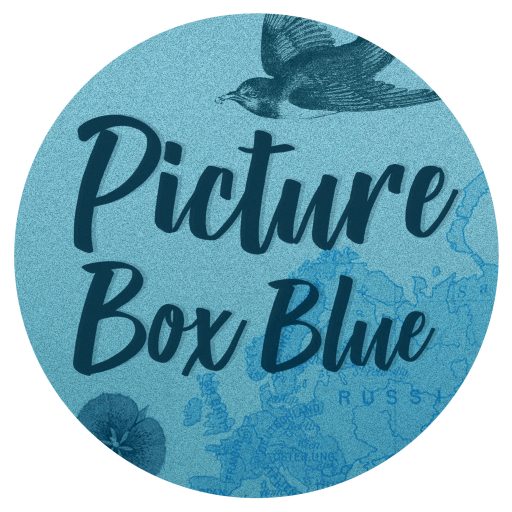
clare hamel
Wednesday 5th of November 2025
When I saw these beautiful wild flower illustrations, I immediately thought of fairies
claire
Thursday 6th of November 2025
Thank you, yes they do have that feel about them.
Kathy
Wednesday 30th of April 2025
Lovely botanicals! Thank you for sharing.
claire
Wednesday 30th of April 2025
Thank you so much. Yes they are one of my favourite collections of wild flowers.
Anu Cocksedge
Friday 11th of August 2023
These are so beautiful! Thank you for making them available, what a talented painter she was!
claire
Monday 14th of August 2023
Thank you, yes she was, they are lovely.
tv
Thursday 21st of July 2022
these are perfect for a bathroom to frame.
claire
Thursday 21st of July 2022
Thank you, glad you enjoyed them.